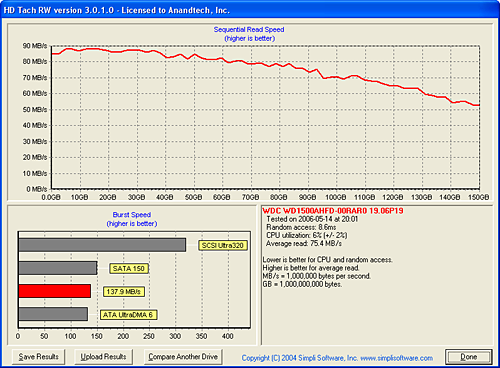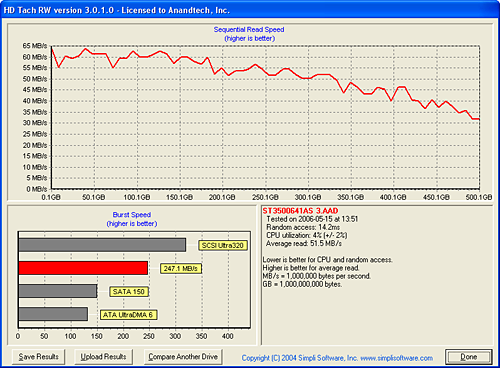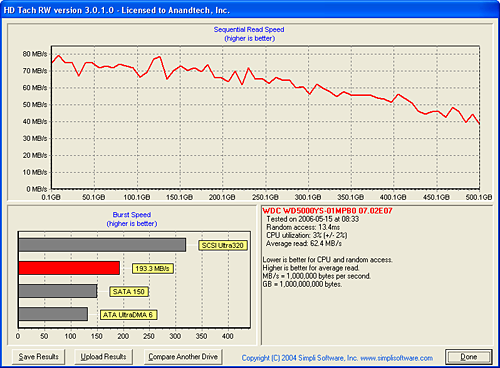Seagate Barracuda 7200.10 750GB: Size Does Matter
by Gary Key on May 18, 2006 9:00 AM EST- Posted in
- Storage
Features and HD Tach Test
| Drive Specifications | ||||
| Seagate Barracuda 7200.10 ST3750640AS |
Western Digital Raptor WD1500ADFD |
Western Digital RE2 WD5000YS |
Seagate Barracuda 7200.9 ST3500641AS |
|
| Manufacturer's Reported Capacity | 750GB | 150GB | 500GB | 500GB |
| Operating System Reported Capacity | 698.6GB | 139.7GB | 465.8GB | 465.8GB |
| Interface | SATA 300MB/s | SATA 150MB/s | SATA 300MB/s | SATA 300MB/s |
| Rotational Speed | 7200 RPM | 10000 RPM | 7200 RPM | 7200 RPM |
| Cache Size | 16 MB | 16 MB | 16 MB | 16 MB |
| Average Latency | 4.16 ms (nominal) | 2.99 ms (nominal) | 4.20 ms (nominal) | 4.16 ms (nominal) |
| Read Seek Time | 11 ms | 4.5 ms | 8.7 ms | 11 ms |
| Number of Heads | 8 | 4 | 8 | 8 |
| Number of Platters | 4 | 2 | 4 | 4 |
| Power Draw Idle / Load | 9.3W /12.6W | 9.2W / 10.0W | 8.9W / 10.8W | 7.4W / 13W |
| Command Queuing | Native Command Queuing | Native Command Queuing | Native Command Queuing | Native Command Queuing |
| Warranty | 5 Years | 5 Years | 5 Years | 5 Years |
The Seagate 7200.10 750GB drive we are reviewing today will be compared against two of the leading 500GB drives from Seagate and Western Digital along with the drive that has redefined performance in the Serial ATA market, the Western Digital WD1500 Raptor. While our Seagate 750GB drive is not in the same market sector as the Raptor, we thought it would be interesting to see how the two drives at the top of their respective classes perform against each other in our testing.
We are providing RAID 0 results for the Seagate 7200.10 for comparative results to the single drive. Seagate has recently released updated firmware for the 500GB 7200.9 that improves RAID performance; unfortunately we were unable to complete our testing with the new firmware before publication. Our RAID results for the WD1500 series will be published in our next storage article. The Western Digital 500GB drive is actually from the RE2 family and its design aspects are based upon the Raptor family. We will be having a 500GB roundup in the near future and will include the updated Hitachi Deskstar, Maxtor DiamondMax 11, Western Digital WD5000KS, and Seagate's own 7200.10 unit in our test results.
All of our drives are tested with Native Command Queuing (NCQ) enabled if the drive supports this technology. The reason for this is that a majority of users will not take the time to toggle NCQ on or off in the drivers so our test results will reflect this pattern. Native Command Queuing performance in single user applications has generally extracted a minor performance penalty when left enabled, with scores generally being 2%~4% lower in the current generation of drives. We noticed a 1% to 3% performance drop with the Seagate 7200.10 in our IPEAK benchmarks but nothing that would be noticed in actual application usage. Our recommendation at this time is to disable NCQ in single user environments to maximize the performance of the drive.
In the case of SATA 1.5Gbps/3Gbps operation we will remove the drive jumpers to enable this function if the drive supports it. Unless your core logic chipset and drivers support SATA 3Gbps operation, do not remove the drive jumper as this will generally result in a non-boot situation. The WD1500 Raptor does not support SATA 3Gbps operation and will operate at SATA 1.5Gbps. We did not notice a performance delta in the 7200rpm drives when enabling 3Gbps operation except in our synthetic benchmarks that measure and report burst speeds.
HD Tach




We find HD Tach to be useful for generating random access and average transfer rate results in a very consistent manner. Although the burst rates and CPU utilization rate numbers are somewhat interesting, they tend to be useless in actual application performance comparisons. In real world terms, CPU utilization rates in any DMA based storage system will typically be under 1% in all instances.
The Raptor has the highest average read rate of 75.4 MB/s with the Seagate 750GB drive following fairly closely with 66.9 MB/s, the Western Digital 500GB drive at 62.4 MB/s, and falling way behind at 51.5 MB/s is the Seagate 500GB drive. The 7200.10 has improved upon the 7200.9 series in this test by 29%.
The sequential read speed at the 500GB level for the 7200.10 is averaging 70 MB/s while the 7200.9 finishes at 31 MB/s. The Seagate 7200.10 and WD 500GB drives score about 40 MB/s at the end of the disk. In contrast, the WD Raptor finishes with a 52 MB/s result that is about 30% greater than the 7200 RPM drives. However, if you look at the read performance for the first 150GB on the 7200 RPM drives, all three manage higher minimum transfer rates than the Raptor.
The random access time benchmark favors the 10,000 RPM spindle speed of the Raptor, which generates a result of 8.6ms. The 7200 RPM drives results are all close together with the nod going to the WD 500GB drive at 13.4ms and the Seagate 750GB/500GB drives finish at 14.0ms and 14.2ms respectively. The average rotational latency at 10,000 RPM is 3ms while the average rotational latency at 7200 RPM is 4.17ms; what this means is that the head seek speed on the Raptor is significantly faster (~5.6ms) than the other drives (9.2-10.0ms). Although the two Seagate drives have excellent burst rates, we will soon see these results do not directly translate into class leading performance.










44 Comments
View All Comments
Larso - Monday, May 22, 2006 - link
Well, you usually plot dB on a linear axis, taken for granted that the interpreter knows the exponential nature of decibels (+10 dB sounds like doubling the loudness). But since our ears/brain also interpret sound levels in an exponential fashion, its not _that_ misleading...
If you really want to show the soundlevel in a linear fashion, you would have to measure loudness in http://en.wikipedia.org/wiki/Sone">Sone
- Gary: Sorry if I've missed it, when you measured the loudness, was the drive secured to the case with screws, or was it suspended softly? It would be interesting to know how much of the noise was due to vibration, and how much was actual noise emission from the drive.
Perhaps some kind of soft suspension would make the drive noise more bearable, subjectively?
Gary Key - Thursday, May 25, 2006 - link
The drives are suspended via soft rubber bushings in the drive cage in order to equalize the test results between drives (as much as possible). This drive will create an additional low pitch vibration when attached directly but nothing like the sound a Raptor produces when attached directly, subjective opinion of course. :)
TonyB - Thursday, May 18, 2006 - link
how soon till we see 1TB hard drive. 7200.11?Gary Key - Thursday, May 18, 2006 - link
We should see a 960GB drive by Q4. We will see the 1TB+ drives in 2007, maybe earlier depending on how well the new 200GB plus platters test out. Also, if Hitachi or WD press Seagate on the issue in Q4 I am sure it be out early. ;->Zaitsev - Thursday, May 18, 2006 - link
Page 4 reads, "we decided the make the switch at this time as the performance."I enjoyed the article, Gary.
"I would much rather show the benefits of RAID 5, 0+1, 10 in a separate article"
I think that's a great idea, and am looking forward to it.
Gary Key - Thursday, May 18, 2006 - link
The link highlight on the word "applications" right before "we" is hiding the semi-colon somewhat. I will see if we can edit the hyperlink to correct this. :)
Thanks for the comments. We are trying to head in a more technical direction in the storage section. We have some additional audio/video tests coming along with application timer benchmarks that should lighten up the presentation. Also, we did not report WB99, IPEAK Access, Disk Bench, IOMeter, or other benchmarks yet, still gauging what information is valuable, interesting, and required.
JarredWalton - Thursday, May 18, 2006 - link
Actually, he was referring to the word "the" - fixed now, as it should have been "to". :)Zaitsev - Thursday, May 18, 2006 - link
Sorry about that. I will be more clear next time. :)Gary Key - Thursday, May 18, 2006 - link
I will wear my glasses next time.... LOL
peternelson - Thursday, May 18, 2006 - link
Hi,
I can understand why you want to test sound levels as close as 5mm.
However, to someone quickly looking at the results charts without carefully reading the text they might think your db(A)@5mm are comparable with db(A) measurements taken at more conventional distances like 1 metre away.
To avoid such errors being made when comparing BETWEEN reviews, please clearly label the audio charts not just "db" but "db(A)@5mm"